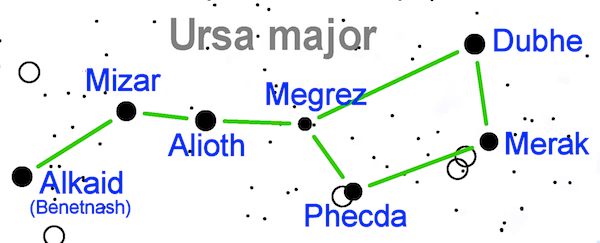It’s finally arrived – the season we’ve all been waiting for ¡!
Day 1, at Midnight
We’re going to start with a constellation which, for us, is circumpolar, which means that, although in  varying positions, it is visible all year round: Ursa Major (ch. 3), whose famous Asterism is the BIG DIPPER, formed by seven stars. ALKAID (chief mourner), at 2 hands to the right of Cadalso; MIZAR, (the sash), above Cadalso, but a little less than 2 and a half hands; ALIOTH (of uncertain etymology), a little higher; MEGREZ (the root of the tail), at a little less than 3 hands, between Cadalso and Torre de Don Miguel; DUBHE (the bear), at a little over 3 hands between Torre de Don Miguel and Gata; MERAK (the loin), above Torre de Don Miguel, a little under 3 and a half hands, and, last of all, PHEKDA (the thigh), a little to the right of Cadalso and at 3 hands. To memorise these beautiful names is not only a pleasure in itself, but it also helps us to locate many other stars of the firmament, for example, if we lengthen 5 times the side which joins Merak and Dhube, we can find the useful but not so brilliant POLE STAR.
varying positions, it is visible all year round: Ursa Major (ch. 3), whose famous Asterism is the BIG DIPPER, formed by seven stars. ALKAID (chief mourner), at 2 hands to the right of Cadalso; MIZAR, (the sash), above Cadalso, but a little less than 2 and a half hands; ALIOTH (of uncertain etymology), a little higher; MEGREZ (the root of the tail), at a little less than 3 hands, between Cadalso and Torre de Don Miguel; DUBHE (the bear), at a little over 3 hands between Torre de Don Miguel and Gata; MERAK (the loin), above Torre de Don Miguel, a little under 3 and a half hands, and, last of all, PHEKDA (the thigh), a little to the right of Cadalso and at 3 hands. To memorise these beautiful names is not only a pleasure in itself, but it also helps us to locate many other stars of the firmament, for example, if we lengthen 5 times the side which joins Merak and Dhube, we can find the useful but not so brilliant POLE STAR.
Now it’s the turn of the most visible Zodiac constellation this month (in front of which, obviously, the sun  isn’t passing, meaning it’s not the corresponding sign of the Zodiac): Leo (ch. 5). It’s most brilliant star is REGULUS (little king), at 3 hands above Calzadilla. Also to be noticed are DENEBOLA (the lion’s tail), at a little less than 2 and a half hands looking towards Montehermoso, and ALGIEBA (the lion’s mane), at a little over 3 hands to the right of Morcillo. The asterism in the shape of a SICKLE, representing the head, extends between Puebla de Argeme and Rincón de Obispo, at a little over 3 and half hands.
isn’t passing, meaning it’s not the corresponding sign of the Zodiac): Leo (ch. 5). It’s most brilliant star is REGULUS (little king), at 3 hands above Calzadilla. Also to be noticed are DENEBOLA (the lion’s tail), at a little less than 2 and a half hands looking towards Montehermoso, and ALGIEBA (the lion’s mane), at a little over 3 hands to the right of Morcillo. The asterism in the shape of a SICKLE, representing the head, extends between Puebla de Argeme and Rincón de Obispo, at a little over 3 and half hands.
And finally, two less famous constellations: a part of the very long Hydra (ch. 15), in which are the HEAD, shown as a little circle, at a little over 2 and half hands to the left of Moraleja, and ALPHARO (the solitary one), a little to the left of Casas de Don Gómez and at 2 hands. The other one is the Lynx (ch.20), of which we will only notice  ALFA-LYN, at a little over 4 hands between Huélaga and Calzadilla.
ALFA-LYN, at a little over 4 hands between Huélaga and Calzadilla.
On March 20th, at 16.57 on T,U. (see ch. 1 of this series) the sun will announce to us the beginning of the new season in the northern hemisphere – joyful Spring !
Y que así sea.
And so be it.








